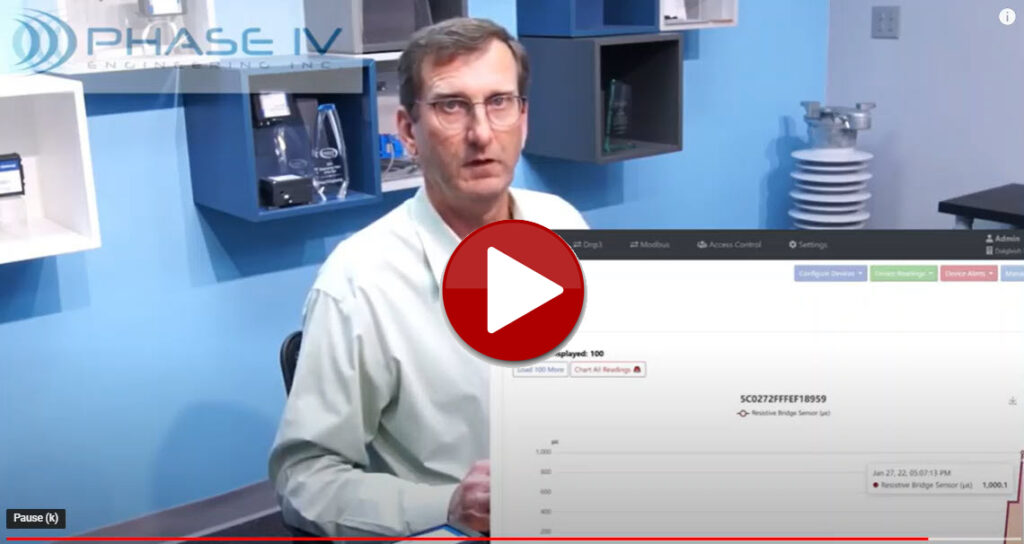-
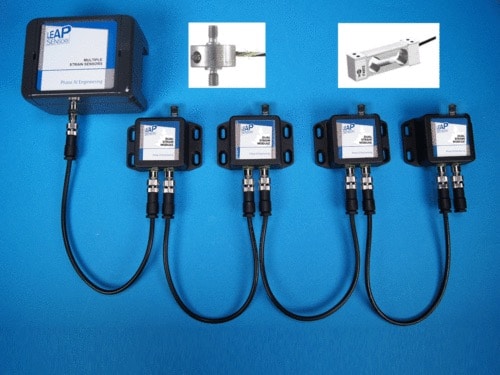 Breakthrough technology uses CAN bus to "daisy chain" multiple load cell interface modules to one wireless Leap transceiver node. Anywhere from 2 to 30 load cell modules can be added to the bus. Each load cell module can support 2 full-bridge mV/V load cells, for a total of up to 60 load cells per transceiver node. Edge processing at the strain sensor level assures a high-quality conversion of the sensor voltage reading to a digital reading, which can then be reliably sent via the CAN bus to the wireless transceiver node. Industrial CAN bus cables can be over 600 feet long. Ideal for wireless monitoring loads and force in several places along structural components such as I-beams, girders, support columns, etc. Contact us to find the best strain sensor configuration for your specific application. Part of the breakthrough Leap Sensors® system. Contact us for pricing on your specific configuration. Build your quote here:
Breakthrough technology uses CAN bus to "daisy chain" multiple load cell interface modules to one wireless Leap transceiver node. Anywhere from 2 to 30 load cell modules can be added to the bus. Each load cell module can support 2 full-bridge mV/V load cells, for a total of up to 60 load cells per transceiver node. Edge processing at the strain sensor level assures a high-quality conversion of the sensor voltage reading to a digital reading, which can then be reliably sent via the CAN bus to the wireless transceiver node. Industrial CAN bus cables can be over 600 feet long. Ideal for wireless monitoring loads and force in several places along structural components such as I-beams, girders, support columns, etc. Contact us to find the best strain sensor configuration for your specific application. Part of the breakthrough Leap Sensors® system. Contact us for pricing on your specific configuration. Build your quote here: -
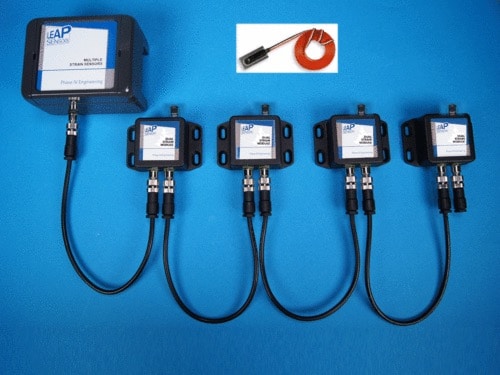 Breakthrough technology uses CAN bus to "daisy chain" multiple small strain gauge sensor modules to one wireless Leap transceiver node. Anywhere from 1 to 16 strain gauge modules can be added to the bus. Each CAN strain module can support 2 full-bridge resistive strain gauge sensors, for a total of up to 32 full-bridge strain gauges per transceiver node. Edge processing at the strain sensor level assures a high-quality conversion of the sensor voltage reading to a digital reading, which can then be reliably sent via the CAN bus to the wireless transceiver node. Industrial CAN bus cables can be over 600 feet long. Ideal for wireless monitoring of strain in multiple points along structural components such as I-beams, girders, hanging structures, support columns, railways etc., as well as industrial applications such as rotating shafts in engines, turbines, etc.
Breakthrough technology uses CAN bus to "daisy chain" multiple small strain gauge sensor modules to one wireless Leap transceiver node. Anywhere from 1 to 16 strain gauge modules can be added to the bus. Each CAN strain module can support 2 full-bridge resistive strain gauge sensors, for a total of up to 32 full-bridge strain gauges per transceiver node. Edge processing at the strain sensor level assures a high-quality conversion of the sensor voltage reading to a digital reading, which can then be reliably sent via the CAN bus to the wireless transceiver node. Industrial CAN bus cables can be over 600 feet long. Ideal for wireless monitoring of strain in multiple points along structural components such as I-beams, girders, hanging structures, support columns, railways etc., as well as industrial applications such as rotating shafts in engines, turbines, etc.Wireless Strain Demonstration and Tutorial
Contact us to find the best strain sensor configuration for your specific application. Part of the breakthrough Leap Sensors® system. Multiple strain sensing modules attach to the transceiver node over a CAN bus. Each module can support two full-bridge strain sensors. The strain modules are ordered separately. Contact Us and an Application Engineer will work with you to provide a detailed final quote that meets your specific application. Build your quote here: -
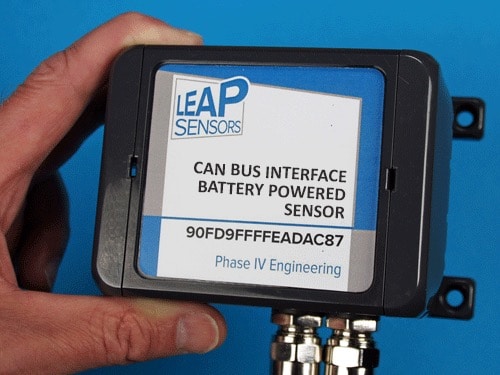 The Leap wireless transceiver can integrate with most sensors with a CAN bus interface. The sensor is powered by the Leap Sensor device battery with a power supply that can be specified from 3.6V to 24 volts. No external power source is needed. Contact us to let us help you make your selected CAN bus sensor wireless. Part of the breakthrough Leap Sensors® system. Contact us with the details of the CAN sensor that you want to integrate with the Leap wireless sensor system. Build your quote here:
The Leap wireless transceiver can integrate with most sensors with a CAN bus interface. The sensor is powered by the Leap Sensor device battery with a power supply that can be specified from 3.6V to 24 volts. No external power source is needed. Contact us to let us help you make your selected CAN bus sensor wireless. Part of the breakthrough Leap Sensors® system. Contact us with the details of the CAN sensor that you want to integrate with the Leap wireless sensor system. Build your quote here: -
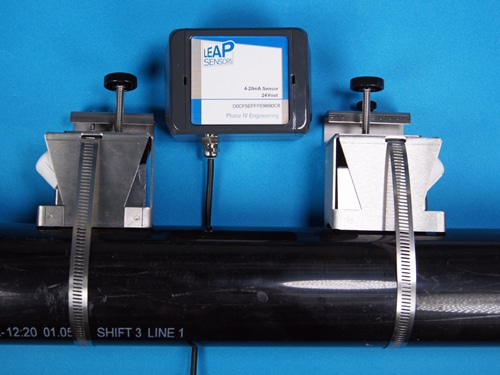 Get instantaneous flow rate information without cutting into pipes and running signal wires. The Leap Sensors wireless transceiver node can integrate with a wide range of ultrasonic and Doppler clamp-on flow meters. Connect to plant software with the Modbus interface or use Leap's cloud-based software. Due to the large power consumption of ultrasonic and Doppler flow meters, the flow meter must be powered by 120V. Data from the flow meter is sent wirelessly via a gateway to the software. Clamp-on flow meters are available for a wide range of pipe sizes from 0.5 to 48 inches. Use for metal or plastic pipes. Contact us to find the best clamp-on flow sensor for your application. Part of the breakthrough Leap Sensors® system. Build your quote here:
Get instantaneous flow rate information without cutting into pipes and running signal wires. The Leap Sensors wireless transceiver node can integrate with a wide range of ultrasonic and Doppler clamp-on flow meters. Connect to plant software with the Modbus interface or use Leap's cloud-based software. Due to the large power consumption of ultrasonic and Doppler flow meters, the flow meter must be powered by 120V. Data from the flow meter is sent wirelessly via a gateway to the software. Clamp-on flow meters are available for a wide range of pipe sizes from 0.5 to 48 inches. Use for metal or plastic pipes. Contact us to find the best clamp-on flow sensor for your application. Part of the breakthrough Leap Sensors® system. Build your quote here: -
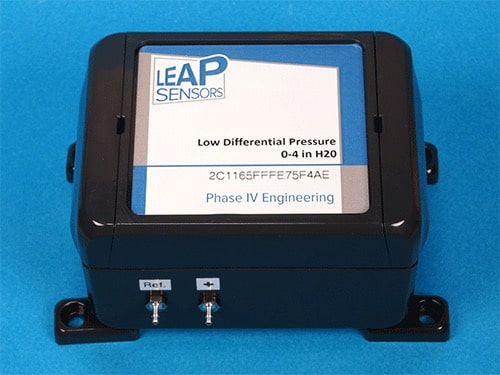 This very unique wireless sensor works by comparing the readings from one device node to another user-selected device node - then reporting the local pressure, local temperature - then differential pressure and temperature as compared to a user selected sensor. For example, sensor A is located outside at ambient temperature and pressure. Sensor B is located in a clean room under positive pressure and Sensor C is located in a different part of the cleanroom under a higher positive pressure. Sensor B could be configured to report its pressure and temperature and the differential pressure between Sensor B and Sensor A. (See the screen shot). Sensor C could be configured to report its pressure and temperature and the differential pressure and temperature between sensor C and sensor B. Sensor readings are reported in PSIA. Leverage the Leap SensorManager software to send text, email, or telephone alerts when a pressure, temperature, or delta-pressure or delta-temperature threshold is exceeded. Integrate the data from the differential pressure sensors into other software using our web-based API, Modbus, DNP3, or other data interface protocols. The wireless sensor can be configured with pressure sensors that have different ranges, resolutions, and accuracies for different applications. See the specification below for more information on the different options. Pressure sensors can be configured to specific applications. The pressure and temperature sensors in the photos have the pressure and temperature sensor sealed inside the enclosure with a pressure port in the back of the enclosure. Part of the breakthrough Leap Sensors® system. Build your quote here:
This very unique wireless sensor works by comparing the readings from one device node to another user-selected device node - then reporting the local pressure, local temperature - then differential pressure and temperature as compared to a user selected sensor. For example, sensor A is located outside at ambient temperature and pressure. Sensor B is located in a clean room under positive pressure and Sensor C is located in a different part of the cleanroom under a higher positive pressure. Sensor B could be configured to report its pressure and temperature and the differential pressure between Sensor B and Sensor A. (See the screen shot). Sensor C could be configured to report its pressure and temperature and the differential pressure and temperature between sensor C and sensor B. Sensor readings are reported in PSIA. Leverage the Leap SensorManager software to send text, email, or telephone alerts when a pressure, temperature, or delta-pressure or delta-temperature threshold is exceeded. Integrate the data from the differential pressure sensors into other software using our web-based API, Modbus, DNP3, or other data interface protocols. The wireless sensor can be configured with pressure sensors that have different ranges, resolutions, and accuracies for different applications. See the specification below for more information on the different options. Pressure sensors can be configured to specific applications. The pressure and temperature sensors in the photos have the pressure and temperature sensor sealed inside the enclosure with a pressure port in the back of the enclosure. Part of the breakthrough Leap Sensors® system. Build your quote here: -
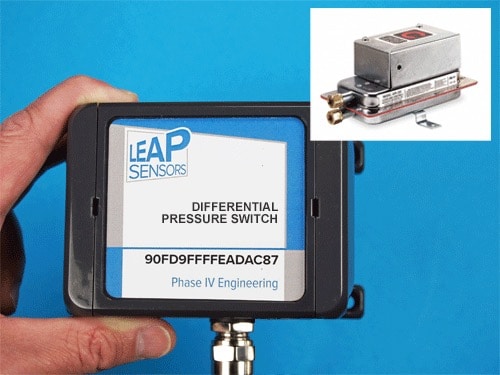 The Leap wireless pressure transceiver can integrate with every type differential pressure switch with a "dry contact" switch output. The differential pressure switch featured with this product is a Cleveland Controls Air Sensing Switch, HVAC/General Purpose Type, 0.02 to 0.8 Differential (In. WC). Contact us to find the best combination or let us know which pressure switch you would like us to integrate. Part of the breakthrough Leap Sensors® system. Build your quote here:
The Leap wireless pressure transceiver can integrate with every type differential pressure switch with a "dry contact" switch output. The differential pressure switch featured with this product is a Cleveland Controls Air Sensing Switch, HVAC/General Purpose Type, 0.02 to 0.8 Differential (In. WC). Contact us to find the best combination or let us know which pressure switch you would like us to integrate. Part of the breakthrough Leap Sensors® system. Build your quote here: -
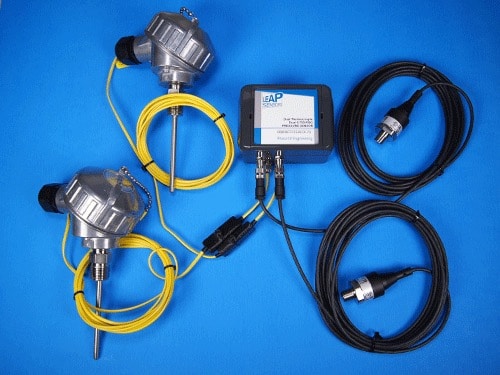 This Leap wireless transceiver node integrates two standard industrial pressure sensors along with two thermocouples. (Type K is standard, but other types can also be integrated). The sensor is powered by the Leap Sensor device battery with a power supply that can be specified - 12 or 24 volts. No external power source is needed. Contact us to let us help you make your selected pressure sensors and thermocouples wireless. Part of the breakthrough Leap Sensors® system. Build your quote here: Contact us for pricing for your unique configuration.
This Leap wireless transceiver node integrates two standard industrial pressure sensors along with two thermocouples. (Type K is standard, but other types can also be integrated). The sensor is powered by the Leap Sensor device battery with a power supply that can be specified - 12 or 24 volts. No external power source is needed. Contact us to let us help you make your selected pressure sensors and thermocouples wireless. Part of the breakthrough Leap Sensors® system. Build your quote here: Contact us for pricing for your unique configuration. -
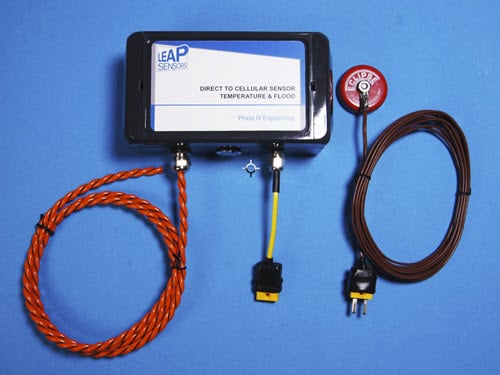 This wireless sensor communicates via a cellular transmission for remote temperature & flood monitoring. The internal antenna keeps the transceiver node small and resistant to damage. Sensor transceiver node combines standard mini k-type thermocouple connector for temperature sensing (wide temperature range) and a water sensor for flood detection. No gateway required – ideal for remote locations where standard sensors won’t work. Sensor node transmits via cellular link directly to cloud-based user interface. Receive alerts by email or text. “Practically battery-free”™ - Long battery life (up to 10 years, depending on application & transmission interval). Customize to your specific needs, including options to transmit only when designated thresholds are exceeded. Part of the breakthrough Leap Sensors system. Build your quote here:
This wireless sensor communicates via a cellular transmission for remote temperature & flood monitoring. The internal antenna keeps the transceiver node small and resistant to damage. Sensor transceiver node combines standard mini k-type thermocouple connector for temperature sensing (wide temperature range) and a water sensor for flood detection. No gateway required – ideal for remote locations where standard sensors won’t work. Sensor node transmits via cellular link directly to cloud-based user interface. Receive alerts by email or text. “Practically battery-free”™ - Long battery life (up to 10 years, depending on application & transmission interval). Customize to your specific needs, including options to transmit only when designated thresholds are exceeded. Part of the breakthrough Leap Sensors system. Build your quote here: -
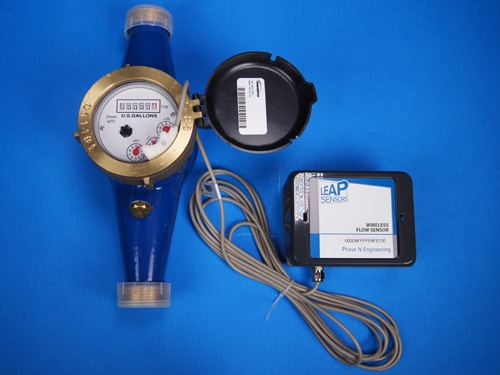 This groundbreaking sensor node integrates a discrete pulse flow meter to count units of flow (i.e. gallons, liters, etc) as liquid flows through a line. Unit can also be used as an incremental encoder for monitoring machinery speeds and total output. The transceiver node times individual pulses and their accumulated counts as they occur. It then uses edge computing to determine current flow rates and total volume of liquid passing through the meter. The edge logic also identifies when flow has stopped, duration of flow events, and duration of stop events. For ease of analysis, the node calculates both instantaneous rate of flow and its duration since the last sensor data reset, as well as a value to indicate if flow is currently occurring.
This groundbreaking sensor node integrates a discrete pulse flow meter to count units of flow (i.e. gallons, liters, etc) as liquid flows through a line. Unit can also be used as an incremental encoder for monitoring machinery speeds and total output. The transceiver node times individual pulses and their accumulated counts as they occur. It then uses edge computing to determine current flow rates and total volume of liquid passing through the meter. The edge logic also identifies when flow has stopped, duration of flow events, and duration of stop events. For ease of analysis, the node calculates both instantaneous rate of flow and its duration since the last sensor data reset, as well as a value to indicate if flow is currently occurring.- Monitors 11 different output variables, such as pulses, flow rate, total pulses, total volume, etc. See specifications for more details.
- Transceiver node is powered by a 120V wall transformer that plugs into a jack on the bottom of the enclosure (no battery powered options available.) Data is transmitted wirelessly via a gateway to the software.
- Connects to the Leap Wireless Sensor System with a secure 2.4GHz, FCC-certified radio.
- Count-reset button on top of the node enclosure resets the total flow at the end of a measurement period. Users can also set automated resets based on time of day.
- This unit is a variation of the Leap production counter, with modifications to account for flow measurement and volume totals.
-
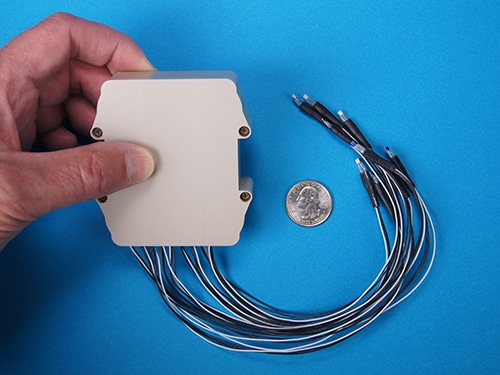 This specially-designed wireless temperature sensor has 9 precision RTDs. The entire transceiver node can operate up to 250ºC (482ºF) - the highest-temperature-rated enclosure we offer. The node is less than 1 inch (2.5 cm) thick - able to ride on a wafer or circuit board through a reflow oven. For wafer temperature monitoring, RTD sensors are ultra-thin and small for a fast response to temperature changes. For other applications, virtually any other RTD sensor can be integrated, including pointed insertion probes for meat or food processing. 3-wire configuration on RTDs assures extra accuracy and immunity to the high-temperature environments. Sensor cable lengths can be made to order. Part of the breakthrough Leap Sensors® system. Build your quote here:
This specially-designed wireless temperature sensor has 9 precision RTDs. The entire transceiver node can operate up to 250ºC (482ºF) - the highest-temperature-rated enclosure we offer. The node is less than 1 inch (2.5 cm) thick - able to ride on a wafer or circuit board through a reflow oven. For wafer temperature monitoring, RTD sensors are ultra-thin and small for a fast response to temperature changes. For other applications, virtually any other RTD sensor can be integrated, including pointed insertion probes for meat or food processing. 3-wire configuration on RTDs assures extra accuracy and immunity to the high-temperature environments. Sensor cable lengths can be made to order. Part of the breakthrough Leap Sensors® system. Build your quote here: -
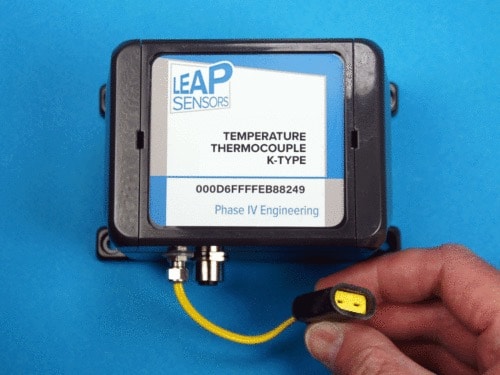 This Leap wireless sensor has two standard mini thermocouple connectors that can connect to any K-type thermocouple. Because thermocouples can be used over a wide temperature range and thermocouples come in a huge range of probe types, this sensor addresses many harsh industrial applications. Part of the breakthrough Leap Sensors® system. Build your quote here:
This Leap wireless sensor has two standard mini thermocouple connectors that can connect to any K-type thermocouple. Because thermocouples can be used over a wide temperature range and thermocouples come in a huge range of probe types, this sensor addresses many harsh industrial applications. Part of the breakthrough Leap Sensors® system. Build your quote here: -
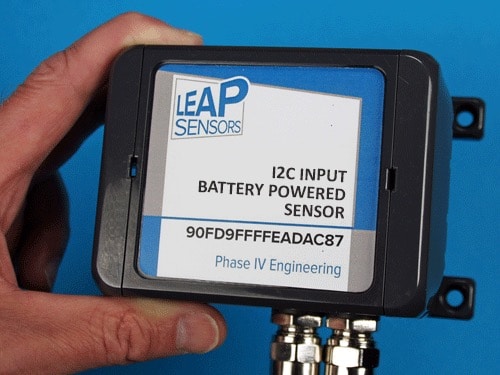 The Leap wireless pressure transceiver can integrate with every type of sensor with an I2C output. The sensor is powered by the Leap Sensor device battery with a power supply that can be specified from 3.6V to 24 volts. No external power source is needed. Contact us to let us help you make your selected I2C sensor wireless. Part of the breakthrough Leap Sensors® system. Contact us with the details of the I2C that you want to attach to the Leap Transceiver Node. Build your quote here:
The Leap wireless pressure transceiver can integrate with every type of sensor with an I2C output. The sensor is powered by the Leap Sensor device battery with a power supply that can be specified from 3.6V to 24 volts. No external power source is needed. Contact us to let us help you make your selected I2C sensor wireless. Part of the breakthrough Leap Sensors® system. Contact us with the details of the I2C that you want to attach to the Leap Transceiver Node. Build your quote here:
